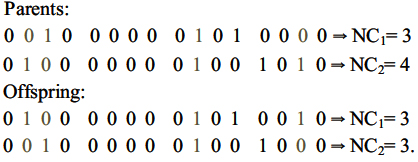两个向量之间的交换元素(交叉)
两个向量之间的交换元素(交叉)
提问于 2017-01-20 09:52:58
假设我有:
chromosome_1 <- c('0010000001010000')
chromosome_2 <- c('0100000001001010')
如何实现步骤3-5?
- 评估
- NC1 =否。在
chromosome_1中的1 - NC2 =否。在
chromosome_2中的1 - M=
min(NC1, NC2)
- NC1 =否。在
- 从
NC生成随机整数range(1, M) - 从
NC中随机选择具有等位基因“1”的基因中的chromosome_1基因位置,并形成一组该位点的s1指标。 从NC中随机选择具有等位基因“1”的基因中的chromosome_2基因位置,并形成一组该位点的s2指标。 s = union(s1, s2)假定s = 2, 3, 10, 15- 对于
s中的每个索引schromosome_1和chromosome_2在i基因位置上的等位基因交换。
以下说明了结果:

我真的很感激你的帮助!
回答 2
Stack Overflow用户
回答已采纳
发布于 2017-02-02 05:40:22
也许不是最简单的解决方案,但有效。
set.seed(12345)
## Step 1
a <- c(0,0,1,0,0,0,0,0,0,1,0,1,0,0,0,0)
b <- c(0,1,0,0,0,0,0,0,0,1,0,0,1,0,1,0)
m <- min(sum(a==1), sum(b==1))
## Step 2
random_int <- sample(1:m, 1)
## Step 3
random_a <- sample(which(a == 1), random_int)
random_b <- sample(which(b == 1), random_int)
#all <- sort(union(random_a, random_b))
## Step 4
## for demo purpose (assume it as the random output)
all <- c(2,3,10,15)
temp_a <- a[all]
temp_b <- b[all]
## Step 5
##crossover
b[all] <- temp_a
a[all] <- temp_b
## Output
> a
[1] 0 1 0 0 0 0 0 0 0 1 0 1 0 0 1 0
> b
[1] 0 0 1 0 0 0 0 0 0 1 0 0 1 0 0 0Stack Overflow用户
发布于 2017-01-21 10:41:49
您可以尝试使用GA封装
在手册(第5页)中有一个例子。
ga(type = c("binary", "real-valued", "permutation"),
fitness, ...,
min, max, nBits,
population = gaControl(type)$population,
selection = gaControl(type)$selection,
crossover = gaControl(type)$crossover,
mutation = gaControl(type)$mutation,
popSize = 50,
pcrossover = 0.8,
pmutation = 0.1,
elitism = base::max(1, round(popSize*0.05)),
updatePop = FALSE,
postFitness = NULL,
maxiter = 100,
run = maxiter,
maxFitness = Inf,
names = NULL,
suggestions = NULL,
optim = FALSE,
optimArgs = list(method = "L-BFGS-B",
poptim = 0.05,
pressel = 0.5,
control = list(fnscale = -1, maxit = 100)),
keepBest = FALSE,
parallel = FALSE,
monitor = if(interactive())
{ if(is.RStudio()) gaMonitor else gaMonitor2 }
else FALSE,
seed = NULL)例如,种群、选择、交叉、变异和监视操作符分配了新的功能。在我的研究中,我使用了自己的突变和监控功能。例如;
myga <- ga(type = "binary",
fitness, ...,
min, max, nBits,
mutation = myMutationFunction
popSize = 50,
pcrossover = 0.8,
pmutation = 0.1,
maxiter = 100,
run = maxiter,
monitor = myMonitorFunction
myMutationFunction <- function (x) {
#...
}
myMonitorFunction <- function (x) {
#...
}因此,您只需定义自己的函数,并将函数名命名为ga函数。为了成为参考,您可以看到默认函数。您可以在默认函数中看到必要的参数和返回值。
页面原文内容由Stack Overflow提供。腾讯云小微IT领域专用引擎提供翻译支持
原文链接:
https://stackoverflow.com/questions/41760637
复制相关文章
相似问题

